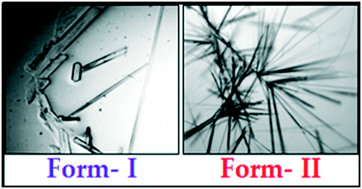Nucleation control and separation of vanillin polymorphs I and II through the swift cooling crystallization process†
Abstract
The supersaturation dependent polymorphic nucleation behavior of vanillin was investigated for the first time in pure aqueous solution by adopting the swift cooling crystallization process. The supersaturation generated by varying the solute concentration produces a significant variation in the induction time, nucleation and morphology of vanillin polymorphs. The nucleation regions of stable and metastable polymorphs are separated in terms of supersaturation ranges. A lower level of supersaturation favours the nucleation of stable form-I and an intermediate level favours the nucleation of both form-I and form-II polymorphs of vanillin. However, higher supersaturation favors the formation of only metastable form-II and the solution mediated transformation of form-II to form-I is evidenced at a faster rate. The morphology of the nucleated polymorphs is identified through optical microscopy and confirmed by optical goniometry. The internal structures and thermal stability of the grown polymorphs are confirmed by X-ray diffraction and differential scanning calorimetry analysis. By this way, the preferred nucleation regions of the two different polymorphs of vanillin are optimized and the solution mediated polymorphic transformation of vanillin in pure aqueous solution is analysed. The main advantage of this technique is the achievement of nucleation control without incorporating any nucleation selecting additives/templates or without the application of any external fields onto the mother solution.

- This article is part of the themed collection: Crystal Growth


 Please wait while we load your content...
Please wait while we load your content...